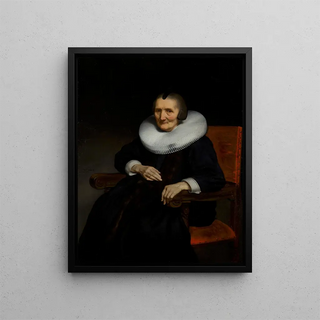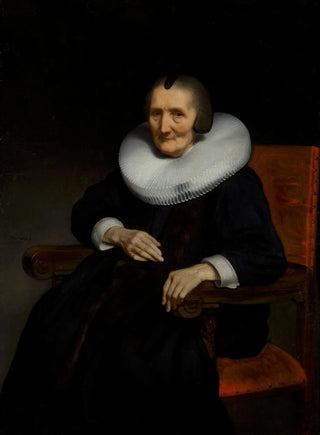Art print | Portrait of Margaretha de Geer 1583-1672 - Nicolaes Maes


View from behind

Frame (optional)
In the fascinating world of 17th-century Dutch painting, the portrait of Margaretha de Geer, created by Nicolaes Maes, stands out for its elegance and psychological depth. This iconic artwork, which captures the essence of a woman of her time, immerses us in a world where light and shadow meet to reveal subtle emotions. Margaretha de Geer, a noble figure and representative of a flourishing era, is depicted with meticulous care that attests to her artist's undeniable talent. Beyond its artistic value, the piece invites us to reflect on the roles of women in 17th-century Dutch society, while celebrating the timeless beauty of its subject.
Style and uniqueness of the work
Nicolaes Maes's style is characterized by an unparalleled mastery of light and a keen attention to detail. In the portrait of Margaretha de Geer, the nuances of color, the interplay of shadow and light, as well as the texture of the clothing, demonstrate refined technique. Maes manages to create an intimate atmosphere, where the model's gaze seems to capture the observer. The composition, carefully balanced, highlights the expressive face of Margaretha, while incorporating symbolic elements that enrich the visual narrative. The chosen accessories, such as delicate jewelry and the luxurious fabric of her dress, are not mere ornaments but elements that tell a story — that of a strong and influential woman of her era. Thus, this work stands out for its ability to combine realism and symbolism, making each detail a reflection of its subject's personality.
The artist and his influence
Nicolaes Maes, a pupil of Rembrandt, established himself in the art world of the 17th century through his innovative approach to portraiture. His career, marked by stylistic evolution, reflects his adaptation to the changing tastes of his time. Transitioning from a style heavily influenced by his master to a more personal and intimate approach, Maes succeeded in capturing the spirit of his era while forging his own path. His work

Matte finish

View from behind

Frame (optional)
In the fascinating world of 17th-century Dutch painting, the portrait of Margaretha de Geer, created by Nicolaes Maes, stands out for its elegance and psychological depth. This iconic artwork, which captures the essence of a woman of her time, immerses us in a world where light and shadow meet to reveal subtle emotions. Margaretha de Geer, a noble figure and representative of a flourishing era, is depicted with meticulous care that attests to her artist's undeniable talent. Beyond its artistic value, the piece invites us to reflect on the roles of women in 17th-century Dutch society, while celebrating the timeless beauty of its subject.
Style and uniqueness of the work
Nicolaes Maes's style is characterized by an unparalleled mastery of light and a keen attention to detail. In the portrait of Margaretha de Geer, the nuances of color, the interplay of shadow and light, as well as the texture of the clothing, demonstrate refined technique. Maes manages to create an intimate atmosphere, where the model's gaze seems to capture the observer. The composition, carefully balanced, highlights the expressive face of Margaretha, while incorporating symbolic elements that enrich the visual narrative. The chosen accessories, such as delicate jewelry and the luxurious fabric of her dress, are not mere ornaments but elements that tell a story — that of a strong and influential woman of her era. Thus, this work stands out for its ability to combine realism and symbolism, making each detail a reflection of its subject's personality.
The artist and his influence
Nicolaes Maes, a pupil of Rembrandt, established himself in the art world of the 17th century through his innovative approach to portraiture. His career, marked by stylistic evolution, reflects his adaptation to the changing tastes of his time. Transitioning from a style heavily influenced by his master to a more personal and intimate approach, Maes succeeded in capturing the spirit of his era while forging his own path. His work






